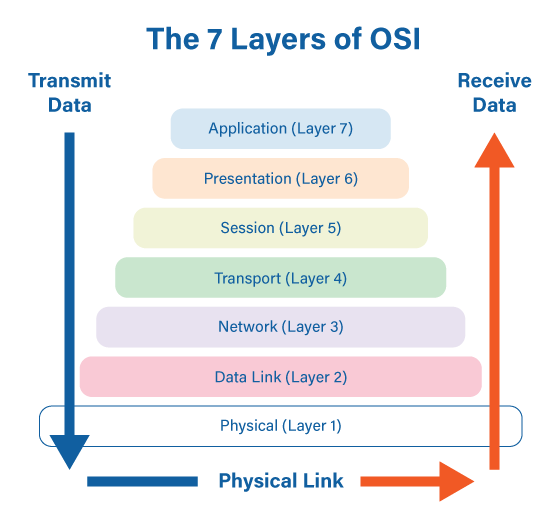Do you know how MESSAGE is sent from your phone to your friends phone?
 MUKUND LOKHANDE
MUKUND LOKHANDE
Understanding How Networks Communicate
In today's digital world, everything from sending emails to streaming videos relies on seamless data transfer across networks. But how does this communication happen behind the scenes? Enter the OSI Model—a fundamental framework that helps us understand how devices communicate over a network.
Whether you’re an IT professional or just curious about networking, this blog will break down the OSI Model’s 7 layers in a simple and practical way.
---
What is the OSI Model?
The Open Systems Interconnection (OSI) Model is a conceptual framework developed by the International Organization for Standardization (ISO). It defines how data travels from one device to another over a network, ensuring smooth communication between different technologies and manufacturers.
The model is divided into seven layers, each responsible for a specific function. Think of these layers like a postal system—each step ensures your letter (data) reaches its destination properly.
---
The 7 Layers of the OSI Model (Explained Simply)
1. Physical Layer (The Hardware & Cables)
🔹 This layer deals with the physical connection between devices. It includes network cables, Wi-Fi signals, and fiber optics.
🔹 Example: The Ethernet cable connecting your computer to the router.
2. Data Link Layer (Ensuring Reliable Data Transfer)
🔹 Manages direct data transfer between two devices and detects errors.
🔹 Uses MAC (Media Access Control) addresses to identify devices on a network.
🔹 Example: A switch ensuring data reaches the right computer in an office network.
3. Network Layer (Finding the Best Route for Data)
🔹 Determines how data moves across multiple networks.
🔹 Uses IP addresses to identify devices.
🔹 Example: A router directing internet traffic between your home and a website.
4. Transport Layer (Reliable Data Delivery)
🔹 Ensures complete and error-free data transfer.
🔹 Uses TCP (reliable, ordered delivery) and UDP (fast but less reliable) protocols.
🔹 Example: TCP ensures your WhatsApp message is delivered in the right order.
5. Session Layer (Managing Communication Sessions)
🔹 Establishes, maintains, and terminates sessions between applications.
🔹 Ensures that your data is synchronized when transferring large files.
🔹 Example: A secure login session on an online banking website.
6. Presentation Layer (Data Formatting & Encryption)
🔹 Translates data into a readable format for applications.
🔹 Handles encryption and compression.
🔹 Example: SSL/TLS encryption securing your credit card details on a website.
7. Application Layer (User Interaction with the Network)
🔹 The layer where users interact with applications.
🔹 Handles email, web browsing, and file transfers.
🔹 Example: Web browsers (Chrome, Firefox) using HTTP/HTTPS to load websites.
---
Why is the OSI Model Important?
✅ Standardization – Ensures different technologies can communicate effectively.
✅ Troubleshooting – Helps IT professionals identify network issues quickly.
✅ Security – Allows network engineers to implement security at different layers.
---
Real-World Example of the OSI Model in Action
Imagine you are sending an email:
1. You type the email in Gmail (Application Layer).
2. The text is formatted and encrypted (Presentation Layer).
3. A session is established between your computer and the email server (Session Layer).
4. The email data is broken into smaller packets (Transport Layer).
5. Each packet gets an IP address for delivery (Network Layer).
6. Packets are sent to the right device using MAC addresses (Data Link Layer).
7. The data is transmitted as electrical or Wi-Fi signals (Physical Layer).
At the receiving end, these steps happen in reverse to reconstruct your email!
---
Conclusion
The OSI Model might seem complex, but it’s a powerful tool for understanding how networks function. Whether you're an IT professional troubleshooting network issues or just someone curious about how the internet works, knowing these 7 layers will give you deeper insights into networking.
Do you use the OSI Model in your daily work? Which layer do you think is t
he most critical? Let’s discuss in the comments!
#Networking #OSIMode #IT #CyberSecurity #NetworkingBasics
Subscribe to my newsletter
Read articles from MUKUND LOKHANDE directly inside your inbox. Subscribe to the newsletter, and don't miss out.
Written by
